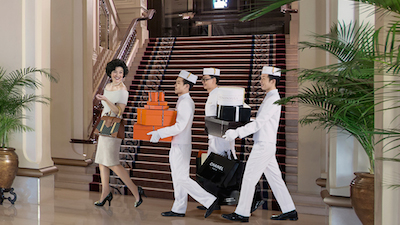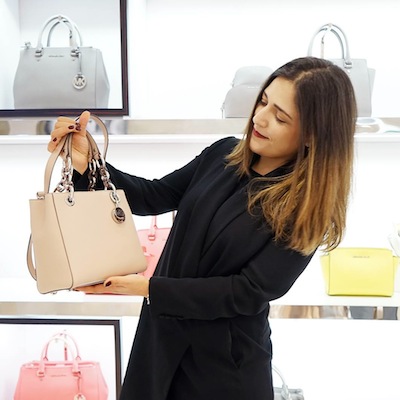NEW YORK – Marketers spend an enormous amount of time and effort attracting millennial attention, when in reality the demographic will only spend approximately $49 billion across luxury categories in 2016, according to a new report by YouGov.
The older generations, the baby boomers and Generation Xers, control the “lion’s share” of luxury spending across nine categories, which include apparel, travel and personal care, among others, for a combined spend of $215 billion for the year. In the inaugural “2016 Affluent Perspective Global Study,” presented in New York on May 3, YouGov forecasts affluent spending, the difference between the two main demographics and how each approaches and interacts with luxury brands.
“It’s important not to lose sight of the fact that this year boomers and Gen X together will spend 4.5 times more than the millennials across the nine categories we monitor,” said Cara David, managing partner at YouGov. “Marketers should be careful not to sacrifice one for the other.”
YouGov’s 2016 Affluent Perspective Global Study was derived from in-depth profiles of the world’s most elite consumers. For the United States, YouGov surveyed 2,515 individuals from the top 10 percent of households, who earn more than $150,000 in discretionary income.
On a whole, YouGov surveyed 5,196 affluent individuals from 11 additional markets such as the United Kingdom, France, Germany, China, Japan, South Korea, Singapore, the United Arab Emirates, Mexico, Canada and Australia.
Foreseeable spending
Overall, YouGov forecasts that there will be a .9 percent decrease in luxury spending in 2016 among affluent demographics.
Millennials and the U.S.’s 400,000 wealthiest households are the exception, with spending expected to increase by 8 and 10 percent, respectively. Research also suggests that the total discretionary spending by the top 10 percent of U.S. households will total approximately $2 trillion.
On a larger scale, discretionary spending across the nine categories is expected to reach $277 billion, a decrease of $2 billion from the year-ago. Despite the slight decrease in discretionary spending, YouGov predicts travel and and fine dining to see an increase.

Image courtesy of Peninsula Hotels
The study showed travel spending to be up 10 percent from 2015 to $119 billion. Age does not seem to be a factor for travel spend, with each age category increasing travel spend by at least 9 percent and millennials spending on travel set to increase by 16 percent.
Also, travel will see an increase from all income categories, Base, Middle and Upper Affluents, by 8 percent to 12 percent.
But, YouGov points out that if the U.S. heads toward another recession, which 56 percent of the study’s wealthiest respondents feel may be on the horizon, leisure travel and dining out will be among the first things affluents cut back on.
Other categories, namely apparel, accessories, handbags, home decor, jewelry and watches, will see an 11 percent decrease in spending from $132 billion in 2015 to $117 billion for 2016.

Image courtesy of DFS
“It is worth noting that a major consequence of the Great Recession among the nation’s affluent is that they are prepared to make immediate adjustments,” said Dr. Jim Taylor, senior advisor at YouGov. “In some cases, the nation’s affluent are even willing to eliminate certain luxuries from their lives altogether, should their household experience a financial setback.”
First timers
Millennials and how to capture the demographic's market share seemingly consume marketers’ time. YouGov suggests that the best way to establish brand awareness among millennials is to target their parents, rather than directly reaching out to the younger, coveted demographic.
This is connected to when and how consumers are introduced to luxury goods and services. YouGov found that 90 percent of affluent millennials had their first luxury interaction by 37-years-old, whereas 72 percent of Gen Xers, 61 percent of baby boomers and 55 percent of matures had experienced luxury by this age.
Luxury is beginning to be introduced to consumers at a younger age because of gifting by the older generations now that they are more established and financially secure. YouGov found that 58 percent of younger millennials, those ages 18-29, and 37 percent of older millennials, 30- to 37-years-old, had their first luxury experience paid for by someone else.

Image courtesy of Lancôme
In comparison, 60 percent of Gen X, boomers and matures responded that they paid for their first luxury good or experience. Therefore, boomers and increasingly Gen Xers, are catalysts for the luxury lifestyle of affluent millennials.
To this point, 61 percent of young millennial respondents shared that their first luxury item or experience was given as a gift by their parents.
In a YouGov study from the 2015 holiday season, its research found that 48 percent of affluents planned to gift a luxury experience over a material good to “make it memorable.” Also, 63 percent shared that they hoped to make the holiday season the best one yet for their family (see story).
For millennials, the price tag associated with luxury goods and experiences signifies its quality. While 69 percent of millennials feel this way, only 51 percent of Gen Xers and 39 percent of boomers agree.
As millennial consumers mature, YouGov feels that characteristics such as quality, construction, retained value and design will best describe luxury goods and services due the demographic having a better understanding of the market.
“Millennials cite price as the number one indicator of luxury,” Ms. David said. “For luxury brands and luxury brand managers, this means that there is a need to help them evolve from a relatively immature consumer to one that will come to appreciate the true value of luxury including the artistry and craftsmanship of the product or experience itself.”
{"ct":"b4i9ZmFqiZ3Mmh6BQGlbWVteFTIZVOzrOB2KMnCoZ1RTt0+wfW+9J2nkoUY9b2zSAWPVarxVPq\/39SecPMgHMJAFRJLXyQjPBEk1Fb30+8jdLjh410Q4zqjBjiIMhkDN3DFoVQqsqnVeIwYLID2Fwf4RJyj246TzRAhMaryubAvpVxxPQAdo\/xHHIs8dtawOhafW4xXchE7FRpf8z\/CYUxBroff3jxUKLofoIfplovn6MVuTDbVP5b65UmIOQoBDPNduJqVNSM4qufYNeLl05cDAtk6Rwc74RemMXnypzJG7QaCM4qfysxEb+4KxHeYiuLjlmRofB\/4RiSfs\/3G7oNflietbAuUoEnBZZ38bspKB4+IWBxj7g3aY3r0OPgf0V1Rd3USwLp1CLGzSC+YqjMUjM1amJFnSKM12vLDdag6nq02ISu76yPTWtyVNYaMI9bnCZy5ROTOKqSUAR\/e6rwgb4Aif5la7bQ0DDXFv02IokEMjtFCT69DXweqC1\/EHAWHk9B\/\/70h6Nj1hxLs2XlZ0gMwZMJoxQVJqU4CEMBeajA\/f44oyDfGBhkpvDaP5DMBHRdeHEg7I0dXXadOlWr9THhXuqlcrbYGAkcwl9RHL31Jfe5laLAu\/Ku2ArXEY0sm9ofOfy9VAklj0wxU+NosuYwlsJ9tXehe9AHA59YeZv5nE9AWC\/X11k6IF2OZCXggOWDX5aWu6dXhdKVmXgxD6aF5s7jdqkHpUQtMOnwb\/OMyJ4zsm9qEvfX\/Lq6ZHnkMbo8QoNkk2m9L7FDuxQ8gjSOYfrD5FxExEfJeycQB29cWnRgfb4RA5MYjTvHWz8M5PXdo2Mm+M0B6q7q7AO2I7i95pQt0Ib64BPb6bqDKJFdUm5KdwLLx3RaUreKVNfpmmXVI2hMND9bpCD2NLC\/jzcouAbFDsq1f1xG8LVaierZHlgIOIpgr7o1LlT6rFYYYyA6wLdy7R\/o622IkPhY6Fkz7I66Ja61SE3ZBd89hqmIwwkR\/1YLDhNUmlt2HdRQDr58a4JfY37L7hsn8zGe0xTeWhblhxbnN3I7y62TtHhUeevQUs+HQxWtLmEL1Vj7jOTqkc8uAwh9F9r93xITnCepKvL3fg0+S48eOrMl1mOq8txne\/fCn5dYllSJ1f3gtnE2ynsA9qvMfGSvfkgTV+eSPlOl8JToUknsoCkQiSwhY1cs8dbdMlY\/wewdY+6aDs1KM0dAEmNIM7s\/H0KVE39sRFtWac6WgDjTRdgIRarWDLU4v6Q0ECmDMextA3\/Zo6HHSjf02iwia5q1EQKM8p19\/h7rWytuRpNlJzW8RXJn1sR8VgjO9bWibumjMCWrDP2JT9IZCbXYhYw83XUjxboHYbt98EatxkzZ9gzQyw6cCuiqq434yijKDTLTSGlFDPQetk6KJgLYpaldmqkS3l0HIEnYHSi7kTTadk\/JvmhD3AGP\/5cz\/rCWx5CYDVenMYshuhK39KKPlt4ZqKEl0\/CdxBRechiZ2LEUp7eg3PuvgQzZuegWVWIxIJ+FXErjb\/tnGc4gi\/4QLN+BngrjEZOK4U9+EET8MymdgqkV8luOInXaAwPQHp4UaTSV9LKfwHzK0fTwJLN4DQTY3e4eKUSQtjg65YbV2GC\/sKsZZcy5J88qoDJ2N67gfHMBJ+6GJIQSWFVCxm+e26WVOojFHrf5aIzzq47LXLBvJbHP9Nv1WFQtshj3g7OkNIdPGOmynWDTOP4WFw3IFTcoFVIDM0o+wkI01y3m3LZLi09D7ll1nLzMyhreUOm1oy0fU1fKUkjQaI+gzDeu7oNDHLk8i\/mBGlG8hMqn4UUK3Z\/PvdDY2QqAoU+Nav6HcA0yl4sMhRx1\/1cGZv6ZYuqyQ4Xy2g3cW6pScagdDdxgOsut94AVvRo5GpAPXOPbVcJ09MwLV2+UO+ByF4HSBFe6AdwVTVreYab6eexWR\/wa9ZZNvcg2nD85pa2o9aN\/e87dJBDFmzWHhzM3XUR5Kklf2RxFQQJ6ii\/j7PMQSpmRXYSoja\/k1ZLGlHlWQ4tkmvlopOdnUWi4XZEzaF58frCI9\/iSywzajOrjfazp+eJ7R2mxW+5FyuM8458ROxfxX34jQq740K2hPLKQ1q+UsP3rDfVvfFOyn\/yOhuuaF4XjyzmDxYMoUXuLDXagX8JaMQwm5whQgNJN\/MutLxNOUPC+BVwWxH3lTxH7MXXWOhxnP\/sI5MoIhdYhCn+Ny\/02WDkUhLLwBTLXj7O6zMZpkhc3evmCTL7D1qrOnoLGu5RON6Rv9vOv9ppxcRcz9Ryddb4ga\/sloOY0G4aGH5lsushbYxCfBbcIV7FGTvCwn\/m3D\/42qFFi4KhK31i2qR9+51DEK77gCFJ8cnjquJXMDkyiVA22y8uDOsA1y83upIsM7nDKw7wTMbvhZpgIbPzgNN\/2satwwRvMzAqmVBWuLO2yIj3Tj9l+2DajbzOZ3IBOT1rgRBG5CEoX6VxTWzJCs1cQcJtDgvD4RrIgDGb7jvZ7Nwa\/2biW1zkMcV0sgj2wIyJfZ78SsHpxEXSSVRWzkWhV9\/eLykGZesWyaJPkoIY0g\/p15\/sm6zicbGpd3jJhuMoRKCkEApwMoMhnOqfC1sv\/CkRCwV2GWeAHLb2D0sAvRKNbK6I2+okln85ahObGmcJ7aYV3yb6Bpe3cbfO4bghqgAJnOkbNizP5V0spCIMMlxWOUiDu78x9PBt7Szf+r2T3NJyLyJMsl0hzdVMQkcZPnDF1kvsusrgDKmPJGnfoHnXS6stPXhdtrJJ2T5xiMVMJGZdMDHlJ76jIbGWwXOTm\/VfiR0CFM4uCOTyqoYFFJB8K1E5EBplHrJvGpX7LUtMfJGdOSOxMSHhjbjyRgsOqbYmhmLoea\/C0Ekj25LEiao\/kBPR6ivPKOhj\/EkfJcQm9UNJ0XIjZsy\/vQPyzcuNPwlqdN3QXUx1w5grnJDVaHyKeO0fIuDqHVqnHx80K4LPoszvDJl8u0Ds67R4dnffaX+1LjhD2SAZQr3bSP8E422Cdxupc5F+XsSiV\/g3iRAINPtu7NwrTsMMuz17BRWBm1Xpo9TBv\/5ne2NckT0wXfVhwvYP183KicWvojBnP\/lX+ZlElXELfIuYCiLVznL6Irvu+GtWHa9Jd6ncSTULiFtOkeydlWLLTQaMiA0su60KnhlEyHh+JrIKKiJTYLxfLeGMGJ4KrbdRtkLjxDR0Ird99FfIFoKLgV3+btITeWhq3IWTtiy5MB6sW6ed4ioQxxS8qjbV+cOpoJAlNdSt1dVZAALC6QXhthgdYQwqfWzcGsj75lF9iMiJa7DQ+IF17GX4CsLh2+8TdabzcVEZTCDLrImr7CMmMaFOPR\/iX3oBMghANF6cWl5uwC7Yn+Gh4Kk09svW\/SARj7TbbHCNqxkBFThHx7c2yV2QsBqlI\/JtgLmQLTB7+uRZXtx\/clskCdtPOOhe2lXPz\/qwii7TYkE\/OD4dNoXA5cePuGY\/cep1dP4CkJownVaBVAMDqh5zXFLWY+2GzczjvOZB2OVF8iWqoccZE2RDsazAm3h\/k390F3P\/P4r68ZrmYRv6l1VTBiANp7BEbcZHtGKHDlbOBSwhA6yHq2kXqdjP08Z5B19O58BPcBDswDs\/V\/RFAVEjvLxIPSov9KDBaqxIcregP9upzhZLyVbKjoFd5eSrXhJBVj+KiTJ0w2\/7J2uDaOFUYJrdKfp8BdKmi\/jHdDEFBbdyElyhlt5MZgmMnijjQQet5g8c2BlV\/edq2\/R4xOyCr0m7zeSIuur6UFnHq95\/7MyOkfdLgp3ouEnJ\/6n1WK6ex\/OFkzyh9X1kJJvnk5D1lEsefwT7gRBkh4aLJFvv9fmuVdCmqEZGdJD2q8yDdgYiU1wddcN+ipbVk8A\/ElAZnVXY9Qan9mEmtEt9OftbBhtDy92gSAWpW0Vwhek4y3tg\/KTNGad8ExHzfqpLWd1dTjcp6IQ\/NhvDApes8PxPw\/uqVKtAHME8wXEu0pqtsfTm9bEXpfqcxA8+uFwCaFj2MXTYqnL7WpZm2w79HVp3+6ki+ilbZyKGsutiMtT2ztIbGPP6xZGJNfuZVXbd3bNXlRUvvhJG7UKQmlA4pyI37as6hs9tHFbDuMibHl3TOnefA8\/f7OQv8C98AH9+pJ+1uwf5N8lC7330X5UNgjwyd6oogNBCdPUmZEvE2IPb8nEajYOGTmabzTe0xDjHzZcXa7W5Ja3kKrcST6nZ9UeiYBnmTrfj4Pp4cFYICqOCheWl3PNHRUAGG\/XDJKyQuWiMb41ygK0PHR2x0a+7Wuo1P\/iM7xborfRsY8VHrKmUMhylpHNQrLKLTsxp72TRbhhgpmJ3kPjzLsBx0sZ\/0IHNEIIzMvm3dM4Nju5v82aM2tvD3jVyR9E8vqpKYCRcxIyIyhBcAh4i2k+dD6wEvWaZlukjuTQ6l0pumzPXgXe8e+wfbXXE8l80xq1rtD9Y7ea+wnPMX7muQBgvNZjx4OLXC1UMfo4NkHFFxzDjfJW+47P6JF6M8Dsi0Jj+LH\/oSKZ4javo\/M45dYxTCNjxpRWilE2bynUBPjlXTWfDDLzNPj94\/Mfeuy2pVaH5yhfkVZvylibYdz7g2vl08PBaQgtfdpTSW0zt5ddTuXnYzlFYxfuzkr7DSzYS75voSit6WMNNk3s3C9ZeNptb7daJeA2zss71pPRd8PcYQLGoA4JDTNewnK7FJu2aXBHs+0gnex4MsksJounNjBGhxZR5+bux7egoqptCmjUDJ0fr86nJHf8cGmvDClLTePeKe0KuXXWsz6+LCSmqXhc\/ac\/NCU6EQbDVpNUHbc3M0Eh\/Hei5OOiuEMb46OOTw7Y6y3bLTc\/cx\/Pehj1MYcL9BjoPmi8NmC8Dom9kDCrTw0LvpszOzD9KNhKkSIXlea33+hepyweugQjyTZzS1VpO6RIqERn6lS06l5G5TtliBjSxe1xLFXmmcelkdQoc9jp5sIUowtA8R+ki7FuMOSvtOkMi246LEngaEJMRLVD8dI\/dsh9NLiNkCEIWh9DsFedZ0Cf1B5LsnEYOMOrs+FokXzDcnVQQWaedLi9N+OLwQqRhTnbAHxX3ueZzNvFN8jIhoO8TTwl4eGOfIiXwV\/VlZRFx+yfGqTuMScgkNUoSl66wv\/Aerkz8MCD2\/nR045gvx+St4NxXge7Y5JEIstJaoHB8zFWwlWRY8UDZZ8H9fGgoxbDoyAjcl5I0ej8u00tVGvrcYFZtVsYHa9JHLIQ4N5G0mu8Da9qYXnQGvtIBtc0cxST71\/p+XaX8aTrltMdf3hXgzXc5gwh5QT1W5H1IVecOyhjaHkww5CxYCm7+FRgA3G3uY5QkzFdy1hEXzn+2xxnBvBqySScyGMsFQOV7VZkkC7vb+qlT+2TondYFbx8IVqCG5tQrEX37HbsEwK42i2a5dTQ1un0GrSokvPFhz4TmamSb0kgR8w5W6eE9+Un8QpoEQvrfu01\/8PHkLCEJTlGUzqmzFc4jFfN2GulHT1CbNTnjwukD1y6LAguInL6t3I3K483KPIIWO7jDRuvbFw1W2IOsDwvbfPCSfAfCaw9JHi+I8uenbKqW+gy59Q1LHNVrMVq30yQhzkdoVJu1O1H2ygo3Js6vqpBvfBjpgc0zlN30Xfjyh4ZKMqCdXypCFCk+fXKBE1ikurrn5khLuX7zjYYptcxqcY+m7mbXDXaf1Xg0rvd5xc+n\/g+I437DfzzupaxRDT+84d2PIt0qZO7pJssSW7twI4s7C7F7mf72YOhuFgSGJvqn2QdpDwRlQiZKRHDnWuHQguVSfWhLRywAUvY7XenlBpCLyiXlBvncjWGzL8yxTHHM\/1Eeyq5MvxjgD3B6jVkWAJLK5mLI78g4WjYI+w9+6TtKCYEcPOHrpUtOg7jaTnsCpIOvvtH4lYB4x4CyvcqHBFuOljiBYoIwILyTe0D2\/nSH+p1921nYfXhweJy2Z0b3Qadwhs9SE9XyChzEzw0xcFOgb8wSqeVk\/dU\/6i5f7ynd7p1AKaVQTcbelMwS5RrITJV7ICJD7o3+Rcf1x9+ckq+WI6UxnlFa0u9IK\/dj1FUtrM\/Uvmyk0D\/mKLHt7ompw\/kxnQLv\/1CYv3smdPZnAzDTkLxLehLbf5c87n7u5wjvLOLO7swJEqfkEGmQFEbeFLeFAR38me5o9BQvOCCSKPNdI2Ca0LNSRWU9nv7WUtdKpnmDs1slvG+okcFgFr9YDC920mVi3dOs+pvm+0YtxY3eOCecl7pAQzLLHrQCY0RFLva3T8UtOQk1BD15SDX3KYEfb20LLxEtEa\/thy9pdbuqIoAbbu\/8+RoOf0ufED1pPdPJ7+iY2AXE2ZmgFFUWn7OJ9uIT7hotP1GS5Qoskj1rDKR7W+zuUW6ur92IOS3pWvNt1LxnDgn436ku5uWXTwNeunlDFCF+kgklT0miVqBtzS3foOABMkkY3xzEVAYFQkmTgpS\/9f5P8jOeK3eIOFszsTpg\/nTV3oSIKaAouyDLOPWWU6NLtKK3oOK2klYROCzK98ahzk71so8iu1dgn2CkSbAu4Z\/l7zGkfcmp2KVpzh1tUs4AGmcl6PHRbULJl3u9yzAuL4cumc\/eZvZkj\/MyPomKAj9wQa4\/EtdrDnUwWRM6Friyi0hCAMOIz6MVTdji3rr0vbA3Ulls76ZV2U4+ac\/TiI10mxiS04Uk+xuDULPnJarCyk\/YORvXPS4ySZn\/taZjqn0jrTfnN8WolVaVroZg2QWeXiLT0jD3n\/5wm8SUmSH+jgPmi6M1TgTKB7644sY1wFos7lqOrhODcK4vhLTPSrg59ur2IwJKmQg4cBELV1hyidmUBhjTaqmLrPBgIzsSt2PVcKKbtnkp1qbAfz0uE91Id8zoQ1TwdrBVmXEXO40alowZL28tCndUgfiyHHac3JmeW3\/z\/3wdB6NeZLJD0\/14qFpHlrUDlc2JV1aP8BKwSlk2DC1dWhmMm7ANk39vfXKBov6FhYu9LIuMCHhD1uRM23dwY9lK8kg5INN8MppPKL8060jLY9MsXVS4gvQapJnRKixDLgfe98QiOSn7ci280vIf+T5JePfa+sQ26+r4esznyR5jGNb6\/E9NM14IlprDCwxF15Hl08mrqHF4QMboca3+y21pBB5gJf6UjTJ6tBm5OhQJrQIftI0uYo43e563BJLmXbE4yxza3KtsUseBc5etjdsv7WE4P0+IO3Z2WD+I9ly37HxsHjZrkuRD01T7qWOHUV53GYRv6ln\/cY2XB4dEJ+KLxeH9q88dfwOF2IPPYOfj7yFwU29jMEwOrPc5Iz7+cmgEBRaE066U3d9iGL85FMGnYd2o0vex0Bb5Vaimqef6zKBIi6e7eP5InJC9incniL8AFYKzFylUtJt2DyfxxZfSKM51Xs3bAhHVDW4eM6lekZBOx5de1u7LmrXs1WOvSZ9LxoSSdv5sLQx1JAtUXnC8jMZm3c4U1v9rJ2RA3ZMWv\/PMmqgyczBh25gESCJnxKl3eLHMv8krOFkDy+DshZB6PEC2ZGDDJ4UtQ5vQxu5PaPiDf6HWK1h6xByHDKTYaj8W3Tgi4xFVMGBBZKDjPh9fw9lnLW7TReUY7OXJlo\/g0i38kFv2lRVqTLQK\/BGu52W9eJ9xk9lGHKIqtKMOD+sgNthqb\/YO0XcrhRBe38giNTDF7BK1ane4kDLfQ0YmG4WrSTNX+JsYP8LWST1s5neGOh9Sn5b\/pzFcmZ0w5yhjr0SPYeABcMq9WclVpVaLZKtg5EE702zoqlL5KRIi4dWb9pVnQ0NbH\/+MqE8JR\/GY30HFwA9cZcip2uh7thnQ+A4pyVudBusS1NeYR3sQ+w2RZRnOSUSIgfbHBM4L1mSY9TI1ZZB7CN7RuKwjejIo1PPcSMD\/UxhNUT3tZaohi3ijBMSwuXhPbeIBmnaAqktzWPp7V\/5INYogwkDvxrrHK4pKXzKVjOjzz3zk\/xYBoYjzv020GSaTLxsXH7J116hHdj9kMpBqGfWY2gHIZOJH+x1q2gLm4Xh2ezkfZg0FiPNrQGh5e67eyyWRKDK4+gifWP7\/aAMARzdjIg9wM6\/qT5ay8hXEEvwNvQG\/xWciurKfoHv26rTzbqZm5LdwLwutfvtlxw7baqSwFDiCzgy+6lytQ6kRkmP3slOk5gWU3pvjW7NOuuIGkV+9H8rhTTmOV4qOTOlULOQA2gpHHlx4tw2e5DvTl1cCjdttz1bfHf8YyuqTQG9gSfuUQnJQld2CITlkyJJfnyVF+Sf\/2n+kOAt2uUOcN49E0OJw5P8\/zCZO9qe8gCs67CMiggQ8LWRV3gf02N2RccQRfiQyIhBU47zxk8Xsswnq3Z8vkhRcBUuNGznmeMNJjdovNhAreLoGgmETw3hGfglPM8Rz6C+kCK+nwKKNUFj93UbAw9bCE6ADMV7j2A9Wsk7eKaFNFY1dxtlKKMnwD8Aj150zTcwIxF+ZnzPDMMhyzPumo9Z4CjQ4mhrn1yMjZ43OuastfnizfC7Q0bbJvHgrZM5Lr7F86ugRXDtN8LD42oYn\/ET1J3qo6V8Z24MlzdvYD\/5CHkfvItOzgzVqeelf01+Sk6zooGjEaXBsFl8X2zhVEpatOOhisvtDL5Re8+ZZV5X\/gPvEtWBym5EsQw55NhC9pl0nLp\/I1bBi7mYQkPgmWYH\/YBz6KnKDtN15DtE8vsBL2q\/b7ZBPBG6o1JwqKq8dWzVNfZ259bFgvv+tcsDae3IcxzhelR0u5mGtTmZGayg\/EgLPJjgoaotDVOJQAd8BOcSfX9y3S55cHJS0PrQ3Qd7p47xQgDnlyspesN\/UetuFqW\/WHRkgx3S+lwpsniam+Pp\/mER95LUUH5F3wj+bRPvJS+4g3zW1mF+EdFyiau8MkCVWAjuu3rf3\/SjsVTBjJxcpFaYWl7d4QIAWmaTf3jrWg0qLwXzsftPEhZCQA\/S19dKh1aFPO2eGSB4OX5iQKyDbx6GOAavfBUvQQXiFf9jMQxT1IOieoUjEU7IZaukw6Jp8vzsquKKgCGN\/njAXIitZG1z94JCdqnRSZxEd5HBtBoG8apw5zYAw92Q4BH6Mvwc6Z1KKF5jAUFeELC+XumZ2EIudHlLpJXbHZHk7ywtMVCOv6eDJ\/QE7QpD9RYulqHf\/FqE8l2OZATpAejRTvHnxZ+bso4RYMkvAUWjfRmFOuFhRbQa\/YhRK5l0siUnSr3HL\/CEOWFhH2odjyLz2II4R8BCjMuM5Ywpg1urgpLJstZNF8byeEAJXSdamvlVsNsovAiOEaUnuh5MX2VR45qtDld0yyWhimWCrDy3hhz4QGo4P5I9nTQDyYDT7ndABLFkMmsTTUVtFikURPfq7AVrUHpttnlf88GDD8dW906WB4MaF+7nMMQKa7op7VOj0x\/zjjdX6bTbunsdAEBs8Wy+j+c5NWoGbPwqzCO4nKpF5ajfgyzmlPG6RKVSgkACy7CEhRuSAVR+zc7IiJdOIOxvn2zz1Smn5PDPvnYVeXwwj07ggMKQH6drTwc2b0\/kToyyj07Ejox87lZOucFbjeF8j8RSs7UHspDG6xsfpOhz6vjYjJ13PyrMB6ZUE41sdAWfsXAftLupxjTGje9AcCJp2WQq8Ry7FAtUm4bsjvnNAv3ARG5UT9z1Johc02EKNciN8YTYdLMjMaTLJA7+y202RiO4NJDR9IA8lWacq26D0+6lSz5CoCGRJdSQjxRTZTz6RHKgADBXE6qhRYtnFHWr9PRS+eZJ+rMAjFsKiJHUiqiZ+o05f8H8bi5k4wO8ht\/waHn\/2\/4Ay35JPrW+DdLF6qkGZlNhfipUgiKNVru5XKTqd8OhLUWZFwUOTEjqKbgJXwkl9Zp2asiUeoHZf9Bqg54eLxpaImbwsNFlOlwBKFV2OVZjziD3ofjYUvkSSQ\/c6Tz2+DM9sn34OuH\/KTdsyW2qaCo3ZDbBeh4e\/z6xdiSGmSpThW9eNqu7HQKvsAtNqXOSkXrNRE0w509oIcVS\/fTd8hkSAOgWYR4mJMm63Qwtpaci\/AU4xZWBcJtgelB6PFEQ\/g+HVqm5XbJD353WzyGikF+QrqS12MTdNlYTo6iU6EKd7Q5YI01AUXiZIBYSQGqsoZpPwqOpHjbVariTfV16kThH83qQkpFmWYhsHfxS6joIybziNgYISV9WxUpv3CYmi2aXjcVKlXp8tZzsWOGHRmKBRBSwhXhhWMKjCshPB9k8fU2eTC82jpbrV\/HeHzZuuHBcdLp8BXGVQnyI3\/q0ytSX7kKqL7oM2KM2QCaJLHK\/QJEHXezpE6PE6n0jtYRO+fqI36+68vAPW3aO4VevdoyFHDL5xab\/IRjtjlcqCSxxwYpyMUZjlrb6VZofyzvkwAE9fZRjmcvEDlVbwY+q3EkUHoiDrOF0zp4iJUI=","iv":"b5db36b391c89f9c7d5b1783256839cd","s":"626005b5c246722c"}
